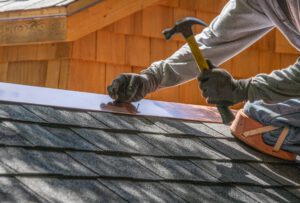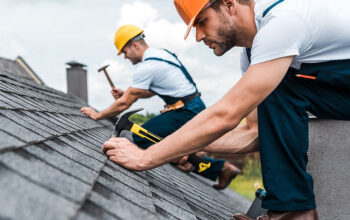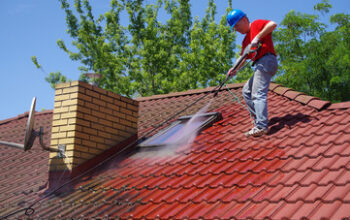The roof is one of the most critical parts of a home. If it starts to go bad, it can cause damage throughout the house and lead to leaks.
The key is knowing when it is time for Roof Repair Near Me or a complete replacement. Look for things like: 1. damage from severe storms.
While asphalt shingles are designed to withstand heavy wind, severe weather can still damage your roof and shingle material. Strong winds, intense sun exposure, hail and snow, and blowing debris can all impact shingles, and your roof is exposed to these elements 365 days a year. While it’s impossible to avoid roof damage, you can perform regular inspections and address minor issues promptly to protect your home from costly repairs in the future.
While a roof repair expert can help you with any significant issues, repairing damaged shingles is a simple task that most homeowners can accomplish themselves. Using a ladder, carefully access the roof and locate the shingle that needs to be replaced. Using a crowbar or pry bar, loosen the adhesive and nails of the shingles two rows above the damaged shingle to reveal the nails below. Loosen the shingle with your pry bar and pull it off, taking care not to damage the overlying shingles.
Obtain replacement 3-tab shingles that match the original shingles on your roof for a seamless look, and apply a thin layer of roofing cement under the edge of each new shingle to create a watertight seal. Slide the new shingle into place and nail it down with four roofing nails. Use a tool belt to keep small tools within reach, and be sure to wear a harness or safety rope to ensure your safety while working on the roof.
It is recommended to have a professional roofer inspect the condition of your shingles after any major storms or if you notice a large number of damaged shingles. Depending on the severity of the damage and how comfortable you feel working on your roof, this may be a job best left to professionals. Performing routine inspections is the best way to catch and address damage quickly before it becomes a leaky roof problem. Be sure to inspect for shingles that are missing or displaced, as well as cracked or rotten fascia, to make sure that you don’t have other issues waiting to be addressed.
Hail Damage
Hail damage can vary considerably depending on the type of roofing material and the structure’s age. For example, asphalt and composition shingles respond differently to hail impacts than wood shingle roofs do. Even so, you can generally recognize hail damage if you examine the roof closely. The most common signs include loosened granules that expose the roof felt, random damage with no discernible color, and dents in the gutters and downspouts, which can reveal hail impact points that are hard to spot. A quick inspection with light-colored chalk will also help reveal potential damage on dark or difficult-to-see surfaces, such as metal shingles.
It’s also important to note that hail damage isn’t always just cosmetic, as dents and other effects can have serious implications for the longevity and performance of a roof. Fortunately, most insurance providers will cover any significant hail damage to the roof, and homeowners should work with a public adjuster to file an insurance claim.
If you do notice damage to the shingles, flashing, gutters, downspouts, chimney, or skylights, it is vital to have them repaired as soon as possible, as they may lead to additional problems such as leaks, rot, mold, and mildew. The good news is that many of these repairs are relatively inexpensive, especially when compared to the cost of a full roof replacement.
Some other telltale signs of hail damage to the roof include water stains in the ceilings or interior walls, wet insulation, wet spots in closets and attics, or damaged window frames, siding, or outdoor air conditioning units. Additionally, if you notice any puddles near the mailbox or metal objects around the home, these can indicate that the roof received direct hits from hail.
In the aftermath of a significant hail storm, be on the lookout for storm chasers who show up at homes to offer free inspections of their roofs and repair estimates. While some of these contractors can be legitimate, it’s important for homeowners to check out their qualifications and work with a public adjuster before agreeing to any services or making any repairs.
Fascia Repair
The fascia board is the long wooden board that sits horizontally on the edge of your roof and connects to the gutter system. It also protects the rafters and trusses, preventing water damage from wind-blown rain or snow that could collect in the eaves. Fascia boards are usually made of spruce, pine, or fir. However, if you want to go with a more natural wood look, redwood, cedar, or cypress are good options. They are also harder and more resistant to moisture, so they can last longer than soft woods like spruce or pine.
If your fascia has become damaged, the first sign is often paint peeling from the edges of the board. This is an indication that the board is rotting, and the damage can spread quickly. If left unchecked, the entire fascia may need to be replaced.
Fortunately, this is a simple process and is considered part of standard roof maintenance. A skilled handyman will remove the old fascia, then measure and cut a new piece to size before nailing it in place. Once the new fascia is in place, the handyman will use caulking to seal the seams of the boards. He or she will also apply a waterproof sealant to the underside of the new fascia to prevent moisture damage from occurring in the future.
In some cases, a professional might need to replace a section of the fascia if it is too damaged. This can be done if the damaged portion of the board only covers a small area and still spans two rafters. Otherwise, the whole board will need to be replaced.
Another common sign of damage is holes or cracks in the fascia boards. Although these might not seem like big problems at first, even a tiny hole can allow water into your attic space. A good repair service will be able to fill in these small holes before they cause any serious issues.
Soffits and fascia boards are often made of wood, but vinyl is also available. If you are considering replacing your soffit or fascia, talk to your contractor to see which material is best for your home. These components are critical to both the structural integrity of your roof and the style of your house.
Skylight or chimney repair
Skylights are a wonderful addition to any home, adding natural light and allowing ventilation. However, like any other part of your roof, it will experience harsh weather and wear over time. Skylights, just like any other penetration on your roof, should be inspected regularly and flashed properly to prevent leaks. Any cracks in your skylight’s glass should be addressed promptly, as they not only create damage to your home but also pose a safety risk for anyone inside the room.
Chimneys are another common cause of leaking on the roof. The flashing around a chimney is designed to keep water from damaging the chimney and your roof over time. The flashing consists of step and counter flashing that is installed over the chimney and then sealed with caulk.
Over time, the flashing will wear out and may need to be replaced or repaired. A professional can help you determine if your chimney flashing is causing a problem and recommend the proper repair for your situation.
When the flashing deteriorates, water can seep into the roof around the chimney and cause extensive damage. The most common area for this to occur is at the base of the chimney. This can often be corrected by installing a chimney catch that diverts water away from the chimney and into the gutters.
If you notice any water spots on your ceiling or walls near your chimney, check the flashing and caulking for deterioration. Chimneys are especially vulnerable to leaking because of their position on the roof. They are exposed to harsh wind, rain, hail, and ice damage. In addition, chimneys are often damaged by deferred maintenance.
It is not a good idea to try to repair your chimney or skylight flashing on your own, as it is very dangerous. You will need to use a ladder, and you may not have the tools and experience needed to complete the job correctly. A professional is your best bet. Not only will a professional be able to diagnose and repair the problem quickly, but they will also make sure that you are safe while doing so.


